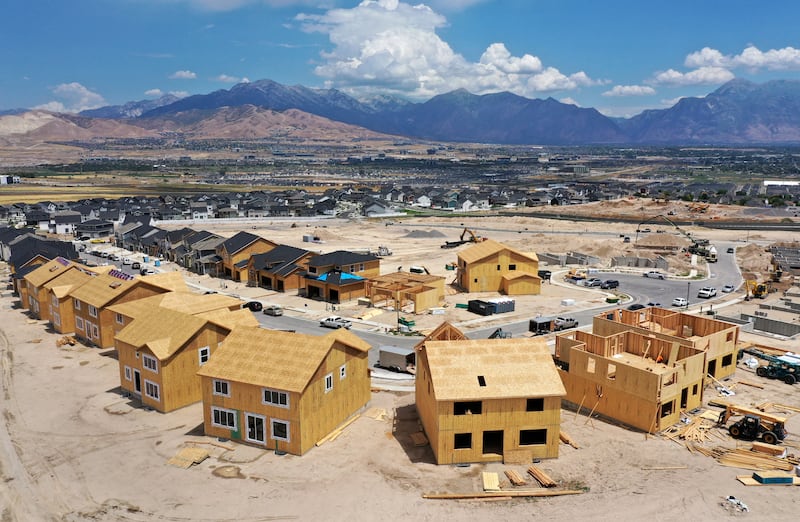Looking at the national map of where in the U.S. homes are being built the fastest, almost the entire state of Utah sticks out as a glaring hot spot.
Using Census Bureau data, Axios recently compiled a county-by-county national map of where housing units are growing the fastest across the U.S. While some geographically smaller counties in Texas boast some of the highest percentages, Utah is high on the national list, too — but with a high concentration of rapidly growing counties statewide.
What’s happening in Utah?
The story here, especially over the last year, is certainly one of a housing boom. In fact, in 2021 Utah saw a “record-breaking home building year” — one that is starting to make a dent in the state’s stubborn, yearslong housing shortage that was driving up home prices even before the COVID-19 pandemic sent the market haywire.
That’s according to a new report released Monday written by James Wood, an Ivory-Boyer senior fellow at the University of Utah’s Kem C. Gardner Policy Institute, and commissioned by the Salt Lake Board of Realtors.
- In 2021, Utah’s number of new housing units permitted far exceeded that of new households (for example, marriages, divorces, students going to college or net in-migration): 40,144 housing units compared to 26,689 new households, according to the report.
So what’s Utah’s housing shortage now? After the record home building year of 2021, Utah’s statewide cumulative housing shortage now stands at 31,000 compared to about 56,000 in 2017.
- “The housing shortage should not be interpreted as 31,000 homeless households, but rather as an indicator of a ‘tight’ and unhealthy housing market characterized by very low vacancy rates and a growing share of households doubling up,” Wood wrote in the report, according to a news release from the Salt Lake Board of Realtors. “Nevertheless, a housing shortage persists at a much lower level.”
What’s driving Utah’s housing boom?
Utah, which has consistently ranked as one of the fastest-growing states in the nation, has experienced rapid population growth for years, and is especially known for its young population.
The state, especially recently, has also seen an uptick in in-migration as out-of-state movers discover it as relatively affordable compared to other states like California, while also offering an impressive array of outdoor recreation opportunities for skiers, hikers, mountain bikers and more.
So as more and more young Utahns seek to start their own families or buy their own homes, that along with an increase in out-of-state movers is driving housing demand, and home builders have been responding in earnest.
What kind of homes are being built?
Utah’s housing boom has been mostly driven by single-family home building. Single-family homes made up 17,528 units or 44% of the share of all permits issued in 2021, Wood wrote in the report.
- Next came apartments. Builders were issued 14,143 permits in 2021, making up 35% of all permits issued. That’s the highest number of apartment permits issued in a single year in Utah’s history, Wood wrote.
- Condos and townhomes came in third place, with 7,895 permits issued, a 20% share.
What cities are building homes the fastest?
One of Utah’s southernmost counties is seeing the fastest percentage growth in housing units of all types, according to census data.
- Washington County — home to booming St. George near popular Zion National Park — saw a 4.7% boost to its housing inventory from July 2020 to July 2021.

Now let’s zoom out and look north, to the Wasatch Front. Tooele County is also among Utah’s fastest growing counties, population-wise and housing-wise.
- Tooele County — known for its rural neighborhoods and vast boundaries stretching all the way across Utah’s West Desert, including across the Salt Flats — saw a 4% increase to its housing stock from July 2020 to July 2021, according to census data.
However, Utah County is really where it’s at when it comes to single-family home building, according to Wood’s report.
- Utah County — Utah’s second-most-populated county and home to Brigham Young University as well as the state’s tech corridor known as Silicon Slopes — saw a 3.9% boost to its overall housing inventory in 2021, according to census data.
Almost one-third of all single-family home permits issued statewide were issued in Utah County, totaling 5,512 units, Wood wrote.
- Three cities in Utah County — Eagle Mountain, Saratoga Springs and Lehi — accounted for 60% of all of the permits issued in the county, according to the Salt Lake Board of Realtors report.
Utah County outpaced Washington County in single-family home building, but Washington County wasn’t far behind. It ranked No. 2 among counties with the most single-family home permits in 2021, according to Wood.
- Salt Lake County — Utah’s most populated county — fell behind both Utah and Washington counties into third place, with 2,235 single-family permits issued.
How much is a home in Utah?
Interestingly, as home building continues to explode across Utah, the median price of existing homes far exceeded the median price of new homes in 2021, according to the Salt Lake Board of Realtors report. That’s even though new home prices have historically been higher than existing homes.
- In Salt Lake County, the median price of a new home has typically been 18% higher than that of an existing home since 2005. But in the second quarter of 2022, Salt Lake County’s median price of an existing home, $603,000, was 25% higher than the median price of a new home, $482,300.
“Why the switch? Location, location, location,” Wood wrote in the report. “Many new home developments are on the periphery, hence considerable distance from employment centers. Thus, the price gap is partly an indicator of the premium the homebuyer is willing to absorb or pay for an existing home closer to employment centers, thus avoiding long commutes from far-flung new subdivisions.”


